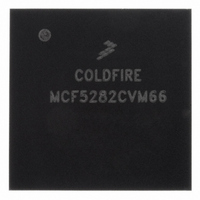MCF5282CVM66 Freescale Semiconductor, MCF5282CVM66 Datasheet - Page 191

MCF5282CVM66
Manufacturer Part Number
MCF5282CVM66
Description
IC MPU 512K 66MHZ 256-MAPBGA
Manufacturer
Freescale Semiconductor
Series
MCF528xr
Datasheet
1.MCF5216CVM66J.pdf
(766 pages)
Specifications of MCF5282CVM66
Core Processor
Coldfire V2
Core Size
32-Bit
Speed
66MHz
Connectivity
CAN, EBI/EMI, Ethernet, I²C, SPI, UART/USART
Peripherals
DMA, LVD, POR, PWM, WDT
Number Of I /o
150
Program Memory Size
512KB (512K x 8)
Program Memory Type
FLASH
Ram Size
64K x 8
Voltage - Supply (vcc/vdd)
2.7 V ~ 3.6 V
Data Converters
A/D 8x10b
Oscillator Type
External
Operating Temperature
-40°C ~ 85°C
Package / Case
256-MAPBGA
Controller Family/series
ColdFire
No. Of I/o's
150
Ram Memory Size
64KB
Cpu Speed
66.67MHz
Embedded Interface Type
CAN, I2C, SPI, UART
No. Of Pwm Channels
8
Rohs Compliant
Yes
Lead Free Status / RoHS Status
Lead free / RoHS Compliant
Eeprom Size
-
Available stocks
Company
Part Number
Manufacturer
Quantity
Price
Company:
Part Number:
MCF5282CVM66
Manufacturer:
FREESCAL
Quantity:
152
Company:
Part Number:
MCF5282CVM66
Manufacturer:
Freescale Semiconductor
Quantity:
10 000
Part Number:
MCF5282CVM66
Manufacturer:
NXP/恩智浦
Quantity:
20 000
Company:
Part Number:
MCF5282CVM66J
Manufacturer:
Freescale Semiconductor
Quantity:
10 000
- Current page: 191 of 766
- Download datasheet (9Mb)
Chapter 10
Interrupt Controller Modules
This section details the functionality for the interrupt controllers (INTC0, INTC1). The general features of
each interrupt controller include:
The 56 fully-programmable and seven fixed-level interrupt sources for each of the two interrupt controllers
handle the complete set of interrupt sources from all of the modules on the device. This section describes
how the interrupt sources are mapped to the interrupt controller logic and how interrupts are serviced.
10.1
Before continuing with the specifics of the interrupt controllers, a brief review of the interrupt architecture
of the 68K/ColdFire family is appropriate.
The interrupt architecture of ColdFire is exactly the same as the M68000 family, where there is a 3-bit
encoded interrupt priority level sent from the interrupt controller to the core, providing 7 levels of interrupt
requests. Level 7 represents the highest priority interrupt level, while level 1 is the lowest priority. The
processor samples for active interrupt requests once per instruction by comparing the encoded priority
level against a 3-bit interrupt mask value (I) contained in bits 10:8 of the machine’s status register (SR). If
the priority level is greater than the SR[I] field at the sample point, the processor suspends normal
instruction execution and initiates interrupt exception processing. Level 7 interrupts are treated as
non-maskable and edge-sensitive within the processor, while levels 1-6 are treated as level-sensitive and
may be masked depending on the value of the SR[I] field. For correct operation, the ColdFire requires that,
once asserted, the interrupt source remain asserted until explicitly disabled by the interrupt service routine.
During the interrupt exception processing, the CPU enters supervisor mode, disables trace mode and then
fetches an 8-bit vector from the interrupt controller. This byte-sized operand fetch is known as the interrupt
acknowledge (IACK) cycle with the ColdFire implementation using a special encoding of the transfer type
and transfer modifier attributes to distinguish this data fetch from a “normal” memory access. The fetched
data provides an index into the exception vector table which contains 256 addresses, each pointing to the
beginning of a specific exception service routine. In particular, vectors 64 - 255 of the exception vector
table are reserved for user interrupt service routines. The first 64 exception vectors are reserved for the
processor to handle reset, error conditions (access, address), arithmetic faults, system calls, etc. Once the
interrupt vector number has been retrieved, the processor continues by creating a stack frame in memory.
For ColdFire, all exception stack frames are 2 longwords in length, and contain 32 bits of vector and status
register data, along with the 32-bit program counter value of the instruction that was interrupted (see
Freescale Semiconductor
•
•
•
•
•
•
63 interrupt sources, organized as:
— 56 fully-programmable interrupt sources
— 7 fixed-level interrupt sources
Each of the 63 sources has a unique interrupt control register (ICRnx) to define the
software-assigned levels and priorities within the level
Unique vector number for each interrupt source
Ability to mask any individual interrupt source, plus global mask-all capability
Supports both hardware and software interrupt acknowledge cycles
“Wake-up” signal from low-power stop modes
68K/ColdFire Interrupt Architecture Overview
MCF5282 and MCF5216 ColdFire Microcontroller User’s Manual, Rev. 3
10-1
Related parts for MCF5282CVM66
Image
Part Number
Description
Manufacturer
Datasheet
Request
R
Part Number:
Description:
Mcf5282 And Mcf5216 Coldfire Microcontroller User�s Manual
Manufacturer:
Freescale Semiconductor, Inc
Datasheet:
Part Number:
Description:
Manufacturer:
Freescale Semiconductor, Inc
Datasheet:
Part Number:
Description:
Manufacturer:
Freescale Semiconductor, Inc
Datasheet:
Part Number:
Description:
Manufacturer:
Freescale Semiconductor, Inc
Datasheet:
Part Number:
Description:
Manufacturer:
Freescale Semiconductor, Inc
Datasheet:
Part Number:
Description:
Manufacturer:
Freescale Semiconductor, Inc
Datasheet:
Part Number:
Description:
Manufacturer:
Freescale Semiconductor, Inc
Datasheet:
Part Number:
Description:
Manufacturer:
Freescale Semiconductor, Inc
Datasheet:
Part Number:
Description:
Manufacturer:
Freescale Semiconductor, Inc
Datasheet:
Part Number:
Description:
Manufacturer:
Freescale Semiconductor, Inc
Datasheet:
Part Number:
Description:
Manufacturer:
Freescale Semiconductor, Inc
Datasheet:
Part Number:
Description:
Manufacturer:
Freescale Semiconductor, Inc
Datasheet:
Part Number:
Description:
Manufacturer:
Freescale Semiconductor, Inc
Datasheet:
Part Number:
Description:
Manufacturer:
Freescale Semiconductor, Inc
Datasheet:
Part Number:
Description:
Manufacturer:
Freescale Semiconductor, Inc
Datasheet:











